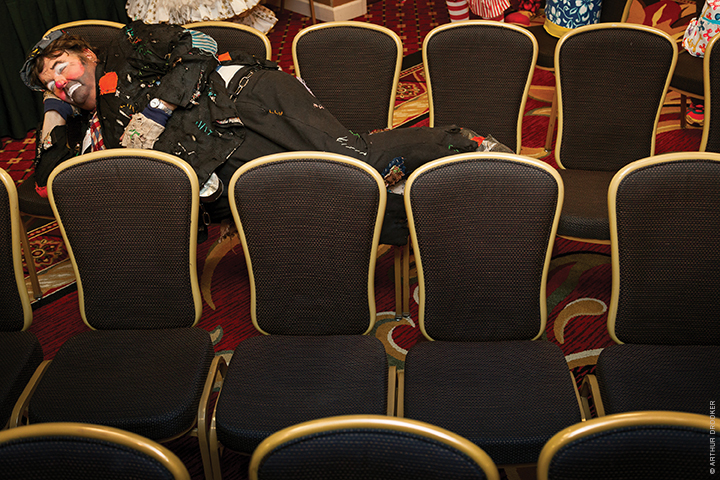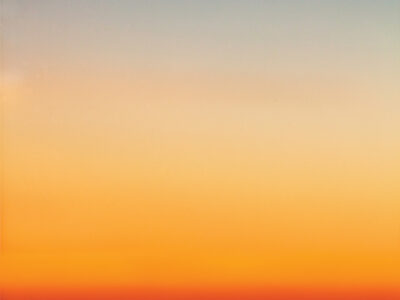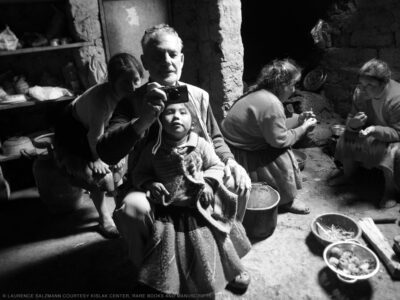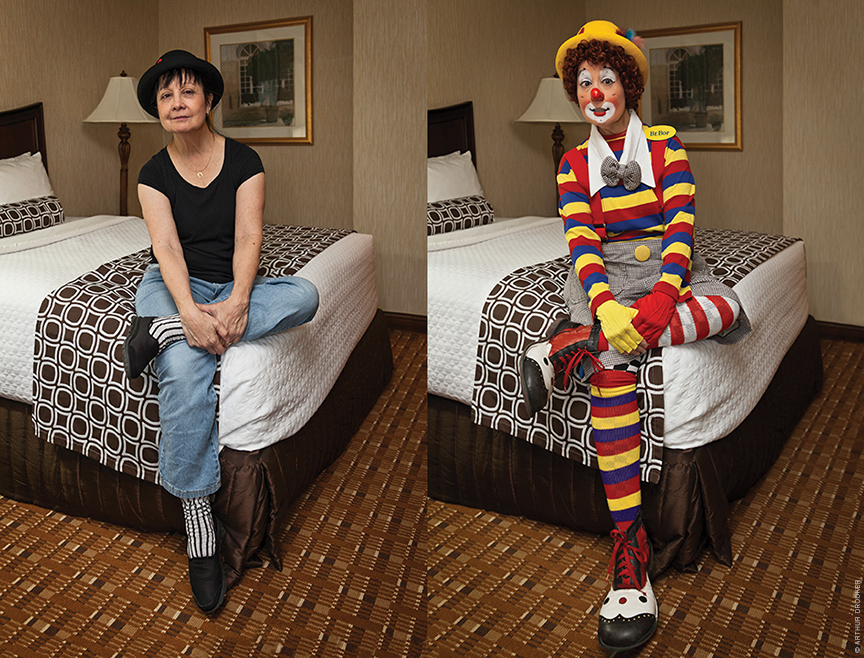
Photographer Arthur Drooker C’76 has trained his lens on American Ruins and Lost Worlds. His new collection, Conventional Wisdom, covers his strangest territory yet.
BY JOHN PRENDERGAST | Photography by Arthur Drooker
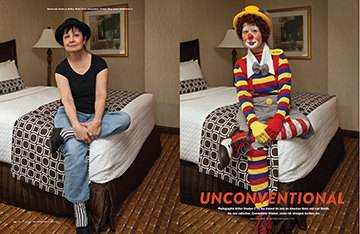
There’s definitely a progression. I don’t think a given book could have happened without the one preceding it,” says Arthur Drooker C’76, of the four photography collections he’s published to date.
Drooker’s first book was American Ruins in 2007 [“Ghost Landscapes,” Jan|Feb 2008], in which he used a specially adapted digital camera to capture otherworldly infrared images of 25 abandoned historic sites in the United States. Lost Worlds, his 2011 follow-up, applied the same haunting technique to ruins in other parts of the Americas [“Arts,” Jan|Feb 2012].
Those books “reflected my love of history and architecture,” says Drooker, as well as “my comfort in photographing things, not people. If I was to grow as a photographer, I knew I had to start photographing people.”
With Pie Town Revisited, published in 2015 by the University of New Mexico Press, Drooker took a big step in that direction.
Pie Town, New Mexico, was originally featured in a set of photographs taken in 1940 by Russell Lee as part of the Depression-era documentary project of the Farm Security Administration. Drooker is a great admirer of Lee’s work, and his book is a combination tribute-update-commentary on those images. Trading his infrared filter for a rich, sharp-edged color palette to match Lee’s Kodachrome prints, Drooker puts his own spin on the older photographer’s landscapes and photographs the descendants of his subjects—sometimes shown holding related Lee photos—and current Pie Town inhabitants.
Returning there for multiple shoots from 2011 to 2014, he gradually made friends and forged strong relationships with members of the Pie Town community, who number about 70, he says. “The trust and intimacy I developed with its residents allowed me to overcome my shyness about photographing people.”
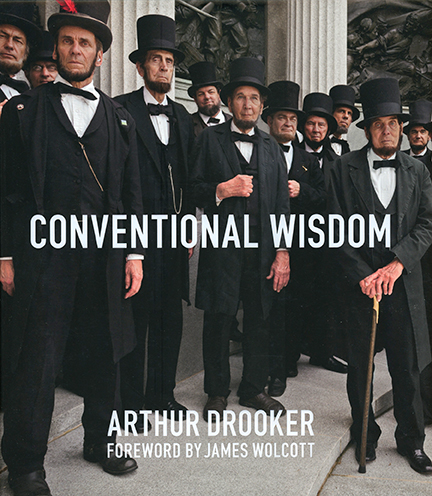
If that experience got his feet wet, Drooker dives into the deep end with Conventional Wisdom (Glitterati, 2016). The new book is “all about photographing people,” he adds, “in some cases, very strange and eccentric people, in large gatherings.”
Those gatherings include conventions for impersonators of Abraham Lincoln and Santa Claus; clowns and military reenactors; people who dress up as mermaids, in animal costumes (“furries”), and as My Little Pony characters(mostly youngish men, they’re known as “Bronies”); not to mention ventriloquists, taxidermists, and fetishists.
In the book’s foreword, the writer and Vanity Fair culture critic James Wolcott describes Drooker as “the urban anthropologist as itinerant photographer. Or is it vice versa?” venturing “through bustling lobbies and down acres of worn carpeting into convention halls and hotel ballrooms, where far-flung tribes gather to display their finery and get their cordial freak on.” He calls the photos “a revelation and a testament that the much-mourned ‘old, weird America’ isn’t quite dead yet. It has simply adopted a new Technicolor dreamcoat of disguises.”
If Drooker chose the 10 conventions he attended with a view to their finery-and-freak-on potential—“the more unusual and photogenic the better,” he writes—he seems a bit more sympathetic to the motivations of the attendees, and to their humanity, regardless of costume. His sharp eye and generosity of spirit both show clearly in the photographs reproduced here, as well as in the interview that follows. —JP
You’ve done four books so far, with widely varying subject matter. What do you look for when casting about for a subject?
It’s really the other way around: Subjects look for me. They attract me and don’t let go. I don’t go looking for them. I like being taken by surprise. I’ve found that’s the best way into a subject. That said, I can see a common thread running through my books even though the subject matter varies. They generally have something to do with culture or subcultures, sometimes with a historical resonance. Not surprising since I was an Am-Civ major at Penn!
How did Conventional Wisdom come about?
Conventional Wisdom came about in what I would call a “sideways” manner—completely unintentionally. In 2013 I began researching a potential photo series about historical reenactors. While researching online, I came across the Association of Lincoln Presenters. These are men who dress up like Abraham Lincoln and present him at reenactments, parades, and other events. On their website they happened to be promoting their upcoming convention. As soon as I saw that, a bell went off in my head. Conventions! Like-minded people coming together to celebrate their shared interest, no matter how unusual. I saw great photographic potential in that. I contacted the Association, seeking permission to photograph its convention. Thankfully, they welcomed me.
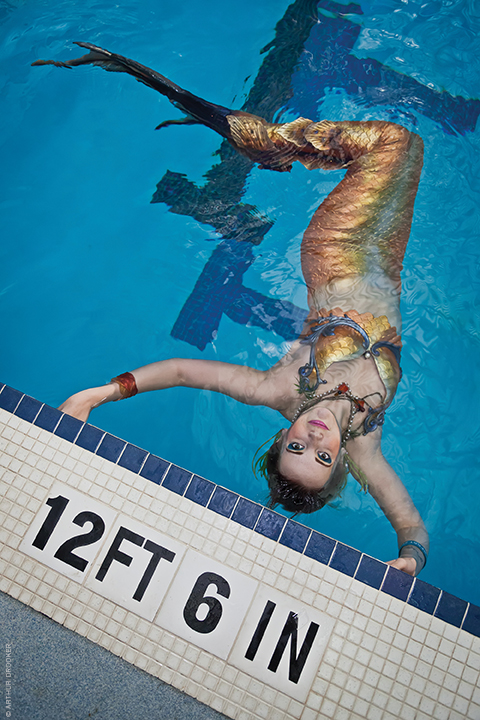
How did you pick the conventions you attended?
I picked conventions that were a bit under the radar. I wanted to avoid the ones that everyone knows about, such as Comic-Con, Elvis Fest, and Star Trek. I also picked conventions that were quirky and photogenic. The ones I eventually selected I did not know about in advance. I found them online after much research, or friends suggested them to me.
What was the shooting process like?
Before each convention I contacted the organizers to introduce myself, explain the project, and ask for permission to attend. I assured them that in no way was I out to make fun of the attendees. They must have appreciated my sincerity because they all granted me permission.
Having secured permission, I would review the convention’s schedule in advance and note those activities that I thought had the potential for the best photographs. This pre-planning was invaluable and imposed some order on what could have been overwhelming.
Once at a convention I would adapt my plan as needed. Sometimes what appeared promising on paper in reality didn’t produce book-worthy photographs. On the other hand, something unforeseen or unplanned for would yield an abundance of images. It’s like being in the army—have a battle plan, but be ready to change it as soon as the shooting starts—only more fun and no one gets hurt.
My biggest challenge at each convention was walking the fine line between being a detached, clear-eyed observer and being human, susceptible to all the stimuli around me. In the end, I like to think I stayed on the right side of the line. That said, I attended these conventions multiple times not only because I needed to do additional photography but also because I wanted to feel again that buzz generated by attendees reuniting. I had made friends with some of them and wanted to see them again. I found their passion, creativity, and fearlessness inspiring.
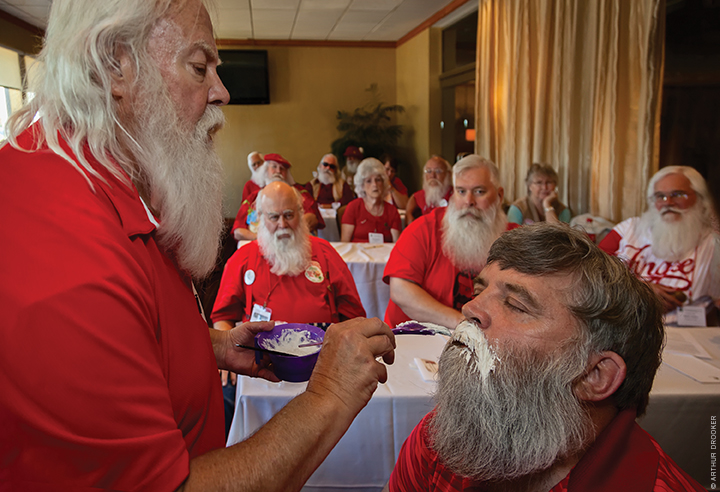
You mention people talking about their gathering as a “family reunion,” or feeling like they are all “brothers and sisters.” Was that true across all the groups, and what else did they have in common?
Without fail, at each convention I attended, I met at least one person who referred to the convention as a “reunion.” It supported my overarching theme that no matter what they’re about, where they’re held, or who attends them, all conventions satisfy a basic human urge: the longing to belong. We’re all searching for our tribe, our family—that group that bonds and accepts us without judgment.
What these conventions also have in common is their structure. From the furries to the fetishists to the Bronies and the mermaids, they all opened and closed with a ceremony, and had a full slate of talks, classes, and demonstrations during the day, large social gatherings at night, and an active vendor room.
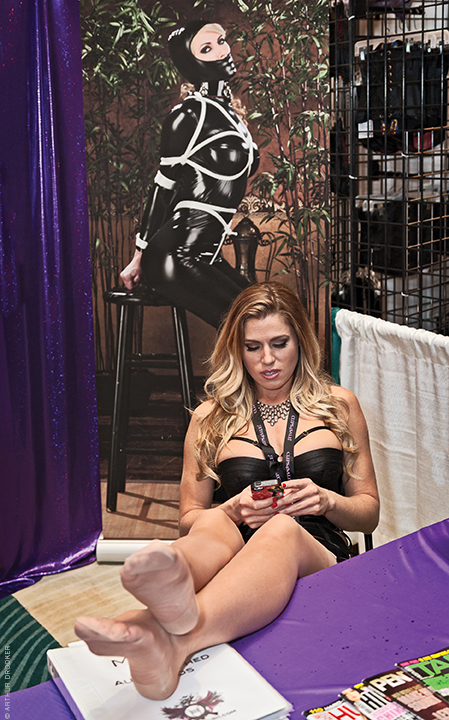
How about things that were unique to certain conventions?
Let’s just say that what goes on at a fetish convention doesn’t happen at a Santa convention.
Some of these groups are seen as just quirky or eccentric—the Lincoln and Santa impersonators, clowns, military re-enactors, for example—while others are sometimes viewed with disapproval or suspicion, such as the Bronies, fetishists, or the people who dress like animals. Your attitude is very accepting of all of them. Was maintaining that stance ever a challenge?
A pre-condition of my being allowed to photograph these conventions, no matter how odd, was that I be accepting. I thought of myself as a cultural anthropologist with a camera. Keeping that attitude was never really a challenge, except for my first day at Bronycon. It took me that long to accept without judgment the sight of young adult males dressed up as their favorite characters from My Little Pony: Friendship is Magic, an animated series originally intended to appeal to young girls. It was only after talking with a couple of psychologists studying the fandom that I gained a better understanding of what the Bronies are all about. I wrote at length about my initial reaction and eventual acceptance of Bronies in the Bronycon chapter of the book.
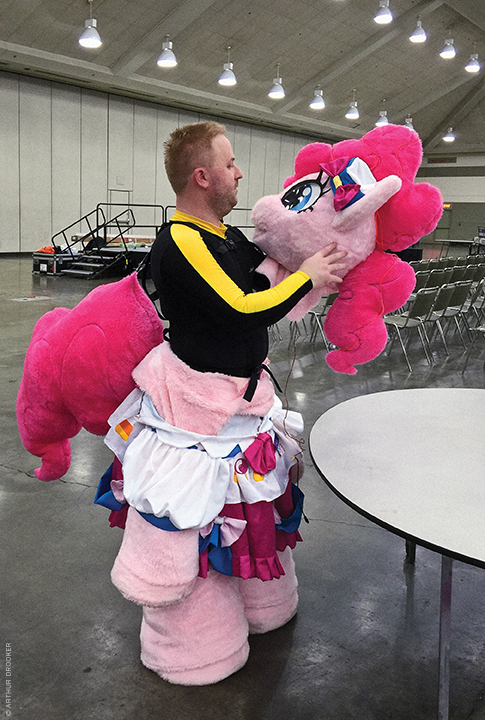
You interacted a fair amount with people at these conventions. What were some of the most memorable moments or characters you encountered?
The one that immediately comes to mind is Renaye Starr at Fetishcon. At 431 pounds, she’s one of the bigger and better known fetish models specializing in feederism, the practice of gaining or helping others gain weight and deriving pleasure, including sexual gratification, from it. She doesn’t conform in any way to societal norms about body image—and flaunts it. She feels more comfortable in her own skin than any person I’ve ever met. Meeting her destroyed any prejudice I may have had against obese people.
Any favorite images, and the stories behind them?
I’ll never forget meeting Thumpie Bunny Eve at Anthrocon, the furry convention. With her gigantic floppy ears and high-heeled furry boots, she was hard to miss. A couple of days into the convention, she beckoned me with a seductive curve of her paw. I was thrilled and terrified all at once. She plopped herself on a piano and asked me to make a photograph of her. She told me that she had observed me at the convention and appreciated the way I went about my work. The observer observed. After I made her portrait on the piano, I interviewed her at length. She turned out to be one of the most intelligent people I met on the entire shoot for Conventional Wisdom.
Photographing Aurora Krause at the World Clown Association convention was a very revealing experience. I had first met her “in-clown,” meaning in costume and make-up. Turns out she had been a bank vice president and gave it up for clowning—she loved doing it that much. She agreed to let me photograph her in- and out-of-clown in her hotel room. When I showed up at the appointed time, she answered the door out-of-clown, in her street clothes. I didn’t recognize her! She looked so different, shy and subdued. She was a bit uncomfortable being photographed out-of-clown. I had to make many exposures to get one that worked. After she put on her make-up and got in-clown, she was completely transformed: more secure and vivacious. I got what I needed in only two or three shots. To me, the dual portrait expresses the power of transformation, which emerged as a sub-theme for Conventional Wisdom.
Was everyone accepting of you? Did anyone not want to be photographed?
Most everyone was accepting of me. Let’s face it: exhibitionists and photographers have always had a wonderful, symbiotic relationship. That said, there were one or two people at the fetish convention who asked that I not make a photograph of them and I respected their request.
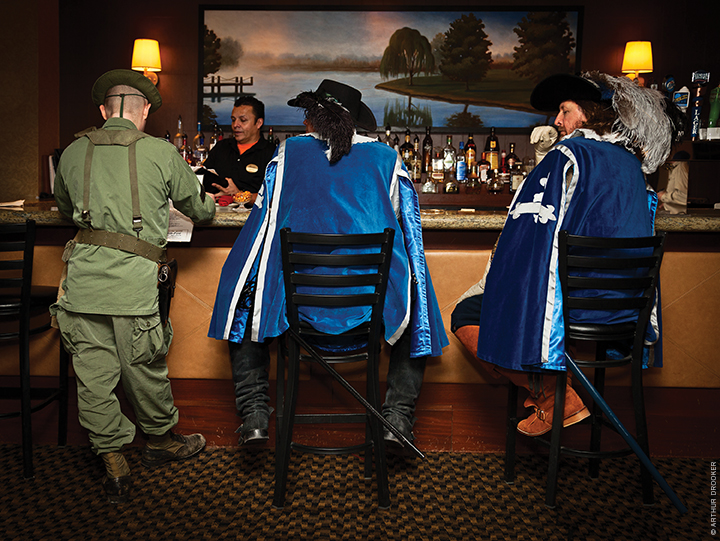
Some of the most striking images are of unguarded moments, where you can see both the fantasy and “normal” life. Was that something that you were looking for?
Very much so. I looked for unguarded moments when reality and fantasy collided or complemented each other. In the case of [the photo titled], “Randy Moore or Less,” the juxtaposition of a fetish model with her feet up, relaxing in front of a life-size poster of herself all tied-up, was irresistible. The tramp clown dozing on the chairs showed reality and fantasy merging. I found humor in such moments.
How did you stage the group shots?
I didn’t stage them. The official photographers hired by the convention organizers staged them (except for the Lincoln group shot). After they made their shots, I had my turn. I usually shot tighter than the official photographers because I knew how I would use the group shots in the book: across the gutter and in some cases, full bleed.
What’s been the reaction to the book so far? Have you heard from any of the people you photographed?
So far the reaction has been very positive in the press, at book signings, and in emails I’ve received from those whom I photographed at the conventions. It’s most gratifying when people’s reactions align with my intention. They get it!
